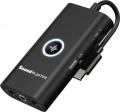Audiochip
Brand of the audio chip installed in the sound card.
The audio chip is one of the most important parts of a sound card, a kind of "heart" of the whole circuit, and it is on its characteristics that the sound quality and other capabilities of a particular model largely depend. Knowing the brand of the chip, you can easily find various information on it — official specifications, test results, reviews, etc. — and based on this, draw a conclusion to what extent this sound card is able to meet your requirements. Of course, for ordinary video cards (see "View") there is no need to delve into such details, but when choosing a gaming or audiophile model, they can be very useful.
iPhone/iPod/iPad
Ability to use a sound card for direct playback from portable Apple devices — iPods, iPhones and iPads. The connection is carried out through a proprietary interface; this not only improves the sound quality, but also provides some additional features (for example, you can switch the track not on the gadget itself, but through the sound card control system, which is often more convenient). An audio card with this feature can be very useful if you plan to frequently listen to music
from Apple devices.
Dynamic Range
The dynamic range of a DAC is the ratio between the loudest sound that the converter can produce and the quietest. The wider the dynamic range — the richer the sound will be, the lower the likelihood that quiet sounds that complement the overall picture will be muffled during conversion. At the same time, it is worth noting that almost all modern sound cards provide a dynamic range that is quite sufficient for comfortable everyday use, and in many models this parameter may not be indicated at all. It is worth paying attention to it when choosing an advanced specialized audio card — for example, a gaming one (see "View"). The minimum for professional models is 90 dB, but in fact, among similar solutions, this figure is usually 120 dB or more.
Signal-to-noise ratio
This parameter determines the ratio of the "clean" sound produced by the DAC at the output to all extraneous noise. As such, it is a pretty strong indicator of sound purity. According to the signal-to-noise ratio, DACs in modern sound cards can be divided as follows:
up to 90 dB — initial level;
90-100 dB — average level, advanced "home" models;
more than 100 dB — professional level.
ADC resolution
The bit depth of the analogue-to-digital converter (ADC) of the sound card. An ADC is a module that encodes an analogue audio signal into a digital format; it is he who is responsible for transmitting sound "to the computer" — for example, through a microphone when communicating via Skype or from a guitar pickup when recording a track. The bit depth is one of the main parameters that describe the quality of the ADC: the higher it is, the less distortion will be introduced into the digitized sound and the higher the maximum possible quality of its recording. Of course, the properties of the actually recorded sound will depend on many other things (hardware, software, settings, file format, etc.), but for high-quality recording, you will definitely need a good ADC.
A bit depth of
16 bits is considered quite sufficient for everyday use, however, even fairly simple models of audio cards are increasingly acquiring
24-bit ADCs.
Max. sampling rate
The highest sampling rate that the analogue-to-digital converter (ADC) of a sound card can provide when digitizing sound. Without going into details, we can say that the role of this parameter is almost completely similar to the bit depth described in the paragraph above. And its standard values, found in modern audio cards, correspond to the following sound quality indicators:
44.1 kHz — Audio CD;
48 kHz — DVD
96 kHz — DVD-Audio 5.1
192 kHz — DVD-Audio 2.0 (two-channel audio has a higher sampling rate than multi-channel audio for a number of reasons), the highest value in modern consumer-grade sound cards.
mini-Jack (3.5 mm)
The number of inputs in the design of the sound card using 3.5 mm mini-Jack connectors. This connector, usually used to transmit an analogue signal, is one of the most popular in modern audio technology. Speaking of inputs, it's worth noting that most computer microphones are designed to plug into the 3.5mm jack; this also applies to separate microphone plugs on headsets. At the same time, the specific purpose of the mini-jack sockets in different sound cards may be different; Moreover, in some models, the same socket can be reconfigured and even change its purpose (from input to output and vice versa). These points, usually, are specified in the characteristics.
Using a simple adapter, you can also connect a 6.35 mm plug (Jack) to the 3.5 mm jack.
Jack (6.35 mm)
The number of inputs in the design of the sound card using 6.35 mm Jack connectors. This connector is in many ways similar to the 3.5 mm mini-Jack described above (and is compatible with it through a simple adapter), however, due to its larger size, it is poorly suited for portable electronics. On the other hand, in the 6.35 mm standard it is easier to implement a three-channel connection scheme and ensure the transmission of a balanced signal (for more details, see "XLR"), which is often required in professional audio work. Therefore, connectors of this type are quite popular in advanced stationary technology, where connection reliability and signal quality are more important than compactness. The Jack input can be used for various purposes, which is usually indicated in the specifications; however, its very presence, usually, speaks of a rather high class sound card.
Note that on balanced XLR models (see below), a 6.35mm input can be built right into the XLR jack; in such cases, these interfaces cannot be used simultaneously.

